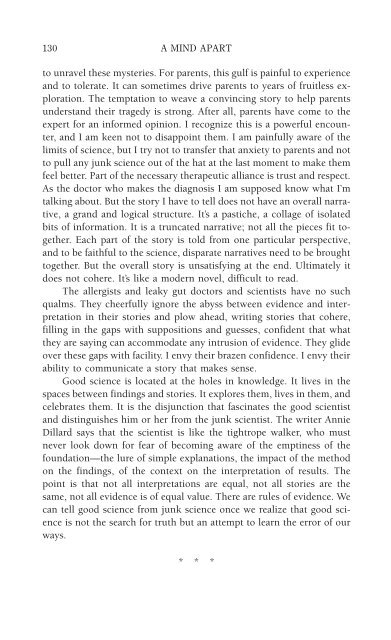978-1572305441
autism
autism
Create successful ePaper yourself
Turn your PDF publications into a flip-book with our unique Google optimized e-Paper software.
130 A MIND APART<br />
to unravel these mysteries. For parents, this gulf is painful to experience<br />
and to tolerate. It can sometimes drive parents to years of fruitless exploration.<br />
The temptation to weave a convincing story to help parents<br />
understand their tragedy is strong. After all, parents have come to the<br />
expert for an informed opinion. I recognize this is a powerful encounter,<br />
and I am keen not to disappoint them. I am painfully aware of the<br />
limits of science, but I try not to transfer that anxiety to parents and not<br />
to pull any junk science out of the hat at the last moment to make them<br />
feel better. Part of the necessary therapeutic alliance is trust and respect.<br />
As the doctor who makes the diagnosis I am supposed know what I’m<br />
talking about. But the story I have to tell does not have an overall narrative,<br />
a grand and logical structure. It’s a pastiche, a collage of isolated<br />
bits of information. It is a truncated narrative; not all the pieces fit together.<br />
Each part of the story is told from one particular perspective,<br />
and to be faithful to the science, disparate narratives need to be brought<br />
together. But the overall story is unsatisfying at the end. Ultimately it<br />
does not cohere. It’s like a modern novel, difficult to read.<br />
The allergists and leaky gut doctors and scientists have no such<br />
qualms. They cheerfully ignore the abyss between evidence and interpretation<br />
in their stories and plow ahead, writing stories that cohere,<br />
filling in the gaps with suppositions and guesses, confident that what<br />
they are saying can accommodate any intrusion of evidence. They glide<br />
over these gaps with facility. I envy their brazen confidence. I envy their<br />
ability to communicate a story that makes sense.<br />
Good science is located at the holes in knowledge. It lives in the<br />
spaces between findings and stories. It explores them, lives in them, and<br />
celebrates them. It is the disjunction that fascinates the good scientist<br />
and distinguishes him or her from the junk scientist. The writer Annie<br />
Dillard says that the scientist is like the tightrope walker, who must<br />
never look down for fear of becoming aware of the emptiness of the<br />
foundation—the lure of simple explanations, the impact of the method<br />
on the findings, of the context on the interpretation of results. The<br />
point is that not all interpretations are equal, not all stories are the<br />
same, not all evidence is of equal value. There are rules of evidence. We<br />
can tell good science from junk science once we realize that good science<br />
is not the search for truth but an attempt to learn the error of our<br />
ways.<br />
* * *



